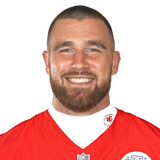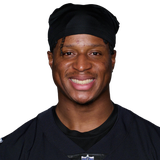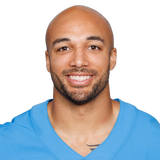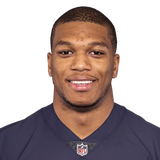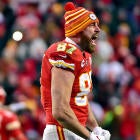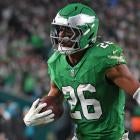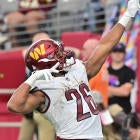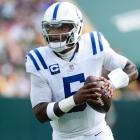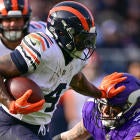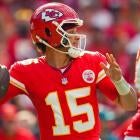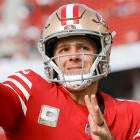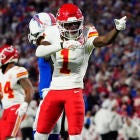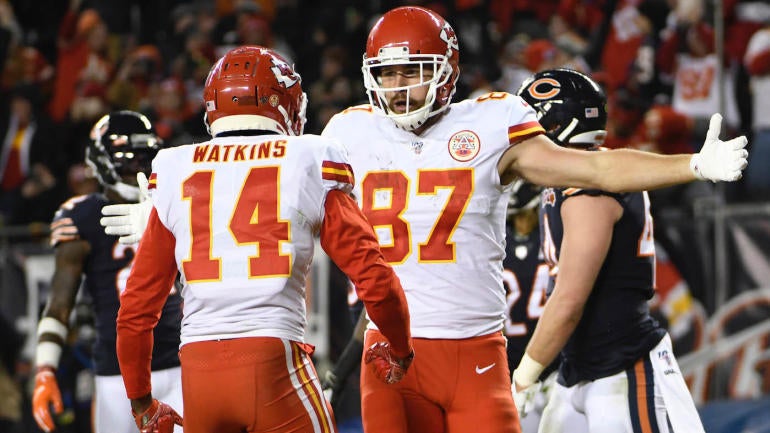
One nice thing about picking at the turn in your Fantasy draft is you've got a ton of flexibility. You've got your choice of the two best remaining players, and you can pretty much go in any direction you want. Want to take the top tight end and pair him with an elite WR or RB? Go for it. Snag a pair of elite WR to avoid the risk of early RB? Sure! Two RB? WR/RB? Heck, you could even draft Patrick Mahomes or Lamar Jackson and lock in that elite QB option — though we wouldn't necessarily recommend that.
The point is, just because you're picking outside of the top-10 doesn't mean you're screwed. In fact, if you play your cards right, picking 11th or 12th can put you in a better spot than anywhere else.
No matter what path you ultimately end up following when it comes time to draft, you'll want to get to know the player pool for 2020, and the best way to do that is to dive into Heath Cummings' breakdown of our top-100 players. He'll make the case for and against each player, so that when you get ready to pick, you can make up your own mind.
Read about No. 11 through 20 below, and get to know the rest of the top-100 players here:
- No. 1-10 - Christian McCaffrey through Miles Sanders
- No. 21-30 - Cooper Kupp through Aaron Jones
- No. 31-40 - Melvin Gordon through James Conner
- No. 41-50 - Lamar Jackson through Courtland Sutton
- No. 51-60 - Stefon Diggs through Cam Akers
- No. 61-70 - Devin Singletary through Hunter Henry
- No. 71-80 - Michael Gallup through Tarik Cohen
- No. 81-90 - Deebo Samuel through Jordan Howard
- No. 91-100 - CeeDee Lamb through Tevin Coleman
| ||||||||||
The Case For: Kelce has cemented himself as the best tight end in the league with four straight 1,000-yard seasons. He has an elite quarterback in Patrick Mahomes and he's one of the few tight ends in the league who is guaranteed 120 targets per year. He's also never had a season below 8.5 yards per target. Last year was a bit of a down year for Kelce because of Mahomes' injuries and bad touchdown luck. He still outscored every other tight end by 32 Fantasy points. That's worth a late first round pick.
The Case Against: Kelce is on the wrong side of 30 and there have been very few tight ends who remain elite late in their careers. The Chiefs also have several young weapons like Clyde Edwards-Helaire and Mecole Hardman who will battle for a small piece of Kelce's target share.
| ||||||||||
The Case For: DeAndre Hopkins has finished as a top-10 wide receiver in four of his past five seasons. Thankfully, we don't have to worry about Brock Osweiler derailing him again, so what could go wrong? While it can be difficult for receivers on new teams to hit the ground running, the Cardinals threw more passes last year than the Texans have each of the past three seasons. Hopkins will have plenty of time to get comfortable with Kyler Murray this summer and should deliver another elite season.
The Case Against: Hopkins' 7.8 yards per target in 2019 was the second lowest mark of his career, but he's only had one season above 8 yards per target in the past five. That's fine as long as he's getting 10 targets per game like he was in Houston, but Arizona's spread offense didn't target any receiver even close to that much in 2019. We have no reason to expect Murray will be a better passer than Deshaun Watson has been, so a significant drop in targets would make it tough for Hopkins to crack the top-five receivers. He's a fine pick in the middle of the second round but he won't last that long in most leagues.
| ||||||||||
The Case For: We thought Chris Godwin could turn the Tampa receiving corps into a 1A/1B situation. We just didn't expect him to displace Mike Evans as the 1A. Godwin's third-year breakout was cut short by injury but even in 14 games he finished No. 2 in all formats behind only Michael Thomas. If anything, Tom Brady should be better for Godwin, as he traditionally focuses on the shorter routes that Godwin runs.
The Case Against: The Tampa Bay Buccaneers threw 630 passes last year. If Brady is still Brady and the defense plays like they did in the second half, we could see a 10% reduction of total pass attempts in 2020. That could mean Godwin doesn't top the 121 targets he saw in 14 games last year, even if he plays 16 games. That becomes a problem because there is no way he sustains his 11.0 yards per target. Regression combined with stagnant targets could make Godwin more of a low-end No. 1 than a top-five receiver.
| ||||||||||
The Case For: Drake was phenomenal once he got to Arizona. In half a season there, he produced 814 total yards and eight touchdowns. While it wouldn't be fair to expect him to double that in a full season, the Cardinals did trade away David Johnson, so Drake will get a chance. If anything, the Cardinals should be a more competitive team with a better offensive line, giving Drake a chance to produce first round value if he stays healthy.
The Case Against: Drake has never handled more than 170 carries or 220 touches over a full season, so we're still not sure he can handle a full No. 1 back role for a full season. Also, the Cardinals traded Johnson for DeAndre Hopkins and could be one of the more pass-heavy teams in the league in 2020. If Hopkins gets the 30% target share, he's used to it could be hard for Drake to replicate the four targets per game he earned in 2019.
| ||||||||||
The Case For: Since Austin Ekeler entered the league 17 running backs have at least 150 targets. None of the other 16 come within a full yard of Ekeler's 8.41 yards per target. He is, without dispute, the most efficient pass-catching back in the NFL. And last year he showed he could hold up to 200-plus touches. Even after Melvin Gordon returned from his holdout Ekeler was a top-5 PPR back. Joshua Kelley and Justin Jackson aren't as good as Gordon, which means Ekeler should be a first-round pick in PPR.
The Case Against: The Chargers are replacing Philip Rivers with Tyrod Taylor (and maybe Justin Herbert eventually). It seems unlikely either quarterback will lean on running backs to the same extent Rivers has in his career. If Ekeler loses short yardage work to the bigger backs and loses targets to Taylor scrambles, he could have a hard time delivering second-round value, much less first.
| ||||||||||
The Case For: Joe Mixon has been a top-12 back each of the past two seasons and there's a ton of reason to think things can be better in Cincinnati in 2020. The offensive line will almost certainly improve with 2019 first-round pick Jonah Williams making his debut. If Joe Burrow delivers on his rookie ceiling the Bengals could have a sneaky good offense and Mixon could have a chance to score double-digit touchdowns for the first time in his career.
The Case Against: First, regarding Burrow, we should not expect him to step on the field and be better than Andy Dalton as a rookie. Dalton is about as close to average as you can get, and rookie quarterbacks have mostly been below average over the past 20 years. The other problem for Mixon is that Giovani Bernard is still on the team, which will continue to cap Mixon's upside in the passing game. Mixon's catch total actually went backwards last year and if he can't get to 50 catches it's hard to see how he has much upside beyond where he's being drafted.
| ||||||||||
The Case For: Henry's combination of size and speed is nearly unmatched in the NFL and he's right at home in Arthur Smith's grind-it-out offense. If Henry plays 16 games, he should be the favorite to lead the NFL in rush attempts, rushing yardage, and rushing touchdowns. He did all three last year in just 15 games.
The Case Against: Henry had 409 combined touches in the regular season and playoffs, so some will worry about him breaking down. More worrisome is his lack of involvement in the passing game. He's never caught even 20 passes in a season. If the Titans regress and find themselves in more negative game scripts, Henry could flounder.
| ||||||||||
The Case For: Chubb took over as the Browns starting running back in Week 7 of 2018. Since then he's averaged 20.4 touches and 105 total yards per game. He possesses both big-play ability and the size and strength to plow through the trenches when necessary. This offseason, the Browns hired Kevin Stefanski, who managed one of the most run-heavy offenses in the league in Minnesota in 2019. Stefanski spent the offseason improving the offensive line, signing a tight end, and trading for a full back. The Browns are going to run enough for both Chubb and Kareem Hunt to be good for Fantasy.
The Case Against: Hunt could still be a problem for Chubb. Chubb still averaged more than 19 touches per game after Hunt was activated in 2019, but he only scored two touchdowns in those eight games and wasn't a top-10 running back in PPR. If this turns into a 60-40 split with Hunt getting most of the work in the passing game, Chubb will need a much better touchdown rate to be a No. 1 back.
| ||||||||||
The Case For: Kittle separated himself from Zach Ertz last year by maintaining the blistering per-game pace he established in 2019. He now belongs in the first tier at the position with Travis Kelce as the only two tight ends who should be drafted in the first two rounds of a PPR draft. Over the past two seasons he's averaged eight targets per game and 10 yards per target, making him a sure bet for 1,100 yards unless he gets hurt.
The Case Against: Kittle has still never scored more than five touchdowns in a season and he still plays on one of the most run-heavy teams in football. If first round pick Brandon Aiyuk has anything to say about it, Kittle's target share could take a hit as well. With Aiyuk and Deebo Samuel around, there's downside that the 49ers finally find a true No. 1 receiver and stop targeting their tight end so often.
| ||||||||||
The Case For: D.J. Moore's 1,963 receiving yards through his age-22 season are the ninth most of all time. He averaged 8.7 yards per target last year despite playing with Kyle Allen and Will Grier, two of the worst quarterbacks in the NFL. Despite that, he still ranked in the top 10 in PPR before a Week 16 injury ended his season early. Touchdown regression and better quarterback play could vault Moore into the top five in 2020.
The Case Against: It's difficult to know how much touchdown regression to expect when a guy has six career touchdowns on 217 targets. It's also difficult to know how a new head coach, offensive coordinator, and quarterback will shake things up in Carolina. Robby Anderson could battle for target share as well. It's certainly possible Moore loses target share to Anderson and cements himself as a consistently low touchdown guy a la T.Y. Hilton or Keenan Allen.
So what Fantasy football sleepers should you snatch in your draft? And which WR1 candidate can you wait on until late? Visit SportsLine now to get Fantasy Football cheat sheets from the model that was all over Derrick Henry's huge season, and find out.


